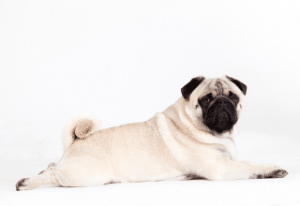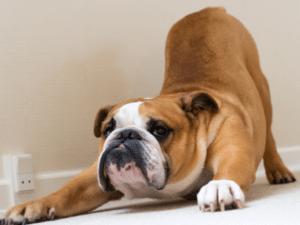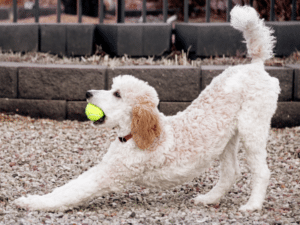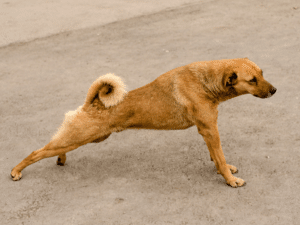Why Does My Dog Stretch So Much? The Hidden Benefits of Dog Stretching Revealed
Estimated 0 min read

Dog stretching out
Every dog owner knows that heartwarming stretch after a nap or the playful bow before a game of fetch. But have you ever paused to consider…”why does my dog do this?”
Beyond the adorable display, stretching holds a treasure trove of benefits for our canine companions. From enhancing physical agility to offering mental solace, these subtle motions are gateways to a world of well-being.
Let’s uncover the mysteries behind these stretches and discover how they contribute to a happier, healthier life for our four-legged friends.
Facts about Dog Stretching
- Dog stretches, like the “downward dog” and “play bow,” serve specific physiological purposes outside of mere play antics.
- Beyond physical benefits, stretching acts as a self-soothing mechanism, especially during periods of discomfort.
- Resistance or changes in stretching routines can be early indicators of potential health concerns.
Why do dogs stretch?

Is this stretch healthy?
Every time your dog stretches, they’re doing more than just waking up or preparing for play. Stretching plays a pivotal role in maintaining their muscle and joint flexibility. As they extend and flex, their range of motion improves, ensuring that they move with ease and grace. This isn’t just beneficial for young, active dogs either. As dogs age, joint pain and stiffness become common adversaries. Regular stretching acts as a gentle combatant, alleviating these discomforts.
But the benefits aren’t just physical. Have you ever noticed a sense of tranquility in your dog following a good stretch? That’s because stretching has a calming effect, reducing stress and anxiety levels. For some dogs, especially those who’ve had a rough day or are feeling a bit under the weather, stretching serves as a self-soothing mechanism. It’s their way of telling themselves—and you—that they’re finding their balance mentally and physically.
Understanding these advantages makes it clear: stretching is more than just a fleeting moment in a dog’s day. It’s a step towards better health and happiness.
Different types of dog stretches

What is the meaning of this position?
“There isn’t just one?” you might be asking. No! In fact, dogs have a repertoire of stretches, each serving a unique purpose.
The “downward dog” isn’t just a yoga pose as it is for us; it’s a natural stance for our furry friends. This stretch, with the front legs extended and the back arched, is a full-body rejuvenation.
Then there’s the “play bow” stretch. Here, the front legs are outstretched while the hind legs remain crouched. It’s not just an invitation to play but a way to flex those muscles.
For those focusing on specific areas, the shoulder stretch is vital. By gently moving a dog’s leg forward and upward, their shoulder mobility improves, and chest muscles loosen. It’s especially beneficial for dogs with longer limbs.
The hip flexors, pivotal for movement, also need attention. By extending the hind limb backward while keeping the back parallel to the ground, this stretch ensures fluidity in their steps.
Lastly, the back stretch, often termed the “cookie stretch,” involves bending their body in a C-shape. It’s a passive yet effective way to ensure spine flexibility.
With these stretches in mind, it’s evident that a few minutes daily can lead to a lifetime of agility and comfort for your pup.
How to help dogs stretch

Dog playing fetch.
Incorporating stretching into your dog’s day doesn’t require a complete overhaul of their routine. It’s about finding those small moments and making them count. Morning rituals are a great starting point. As your dog wakes up, encourage the “downward dog” or “play bow” to kickstart their day.
Before engaging in physical activities like a walk or play, a brief stretching session can prep their muscles. The shoulder and hip flexor stretches are particularly beneficial here, ensuring they’re limbered up for the activities ahead.
Post-activity, as they wind down, reintroduce these stretches. It aids in muscle recovery and reduces the chances of stiffness. For senior dogs or those with joint issues, this post-activity stretch is a relief, easing potential discomforts.
For dogs more resistant to these new routines, positive reinforcement is key. A gentle voice, a treat, or their favorite toy can make the process enjoyable. Over time, as the benefits become evident, resistance will likely wane.
But remember, like any new routine, patience is crucial. Observing your dog’s reactions, adjusting based on their comfort, and ensuring it’s a positive experience will pave the way for a healthier, happier dog.
Things to look out for when your dog is stretching.

Look of relaxing or discomfort?
Dogs, like humans, have their unique thresholds of comfort. While stretching is beneficial, it’s essential to discern between a healthy stretch and potential discomfort.
If your dog hesitates or resists a particular stretch, it’s a cue. They might be experiencing pain or discomfort in that area. A sudden increase in the frequency of their stretches, especially if it’s accompanied by whining or restlessness, can indicate underlying issues.
The “cookie stretch” is more than just a back flex. If your dog refuses to follow the treat or shows reluctance, it might hint at back pain. Similarly, if they favor one leg over the other during the shoulder or hip flexor stretches, it’s a sign worth noting.
It’s also crucial to observe their post-stretch behavior. Limping, reduced activity, or a change in posture can be subtle red flags that there are potential hidden problems.
While these stretches aim to enhance their well-being, it’s vital to ensure they don’t inadvertently cause harm. If you notice any of these signs when your dog is stretching, a consultation with a veterinarian is the next step. They can provide insights into what’s causing your dog discomfort and can offer a treatment plan to get them feeling their best.
How to help your dog stretch safely

You can help your dog with stretching exercises
Every dog is unique, and while stretching is universally beneficial, the approach might need tailoring. It’s not just about the stretch but ensuring it’s done the right way.
Starting slow is the mantra. Especially if your dog is new to structured stretching, easing them into it ensures they don’t get overwhelmed. A gentle touch, combined with soothing words, can make a world of difference.
Consistency is key, but so is moderation. Overstretching or pushing them too hard can be counterproductive. It’s about finding that balance between too little and too much.
Always be attentive. If your dog pulls away or seems uncomfortable, it’s time to pause. Their reactions are the best indicators of their comfort levels. And while treats are great motivators, they shouldn’t be the sole reason your dog stretches. The stretch itself should become a positive experience.
Age is another factor. Puppies, with their developing bodies, have different needs compared to older dogs. Their growth plates are still forming, and certain stretches might not be suitable. Check wit your vet to be sure you’re on the right track.
Lastly, while these guidelines provide a foundation, every dog’s needs are unique. Regular check-ins with a veterinarian or a canine physiotherapist can offer personalized advice. They can guide you on the nuances, ensuring your dog gets the most out of every stretch.
While stretching is a significant piece of the puzzle of helping your dog live healthily, it’s intertwined with numerous other facets that contribute to your dog’s overall well-being. From their diet and exercise to their mental stimulation and regular health check-ups, every aspect plays a crucial role in ensuring they lead a happy, healthy life.
Banixx Dog Blogs
Of course, you already know to be cautious when it comes to your dog’s health – otherwise you wouldn’t be reading this ! That’s why we hope you’ll come back to ourblogto learn more about how to keep your four-legged friend happy and healthy. If on the other hand, you are interested in how to maintain yourdog’s nails/claws, we cover that too. Interested in more quirky items ? such ashow long can a dog go without peeing, yep, we’ve got that. Or, since its Pumpkin time…can yourdog safely eat Pumpkin? You bet! And it’s brimming with healthy ingredients for them! At Banixx, our commitment is to guide you through this journey, offering expert advice, tips, and solutions tailored to your furry friend’s unique needs.


















